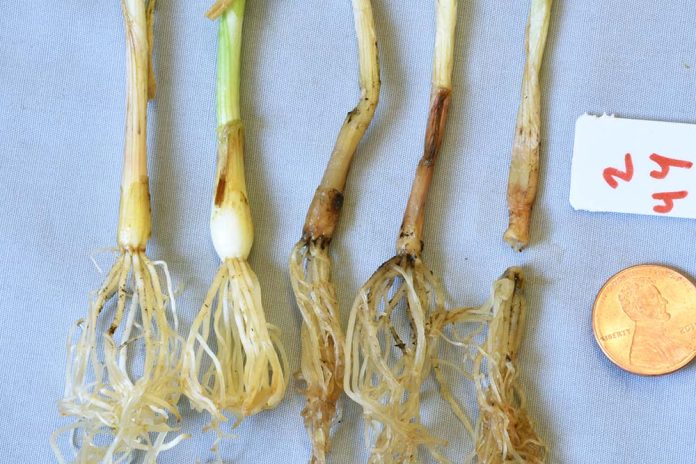
Phytophthora is the genus name given to a group of fungus-like organisms that have tremendous impacts on plants. Recent research indicates Phytophthora is closely related to brown algae and diatoms. Of the many documented Phytophthoras, a few dozen species cause disease on vegetable, fruit, ornamental and forest plants grown worldwide.
Phytophthora has a notorious record for damaging crops. One of the earliest notable cases involved Phytophthora infestans, which caused epidemics of late blight on potato in Europe in the 1840s to 1850s. Devastating losses of potato crops resulted in famines, human suffering and death, and forced migrations. Another species, P. cinnamomi, caused the loss of hundreds of plant species in Australia. Such widespread decline threatens the plant and animal ecosystems in this region. And even closer to home, in coastal California and southern Oregon, P. ramorum (sudden oak death) has killed millions of tanoak and coast live oak trees, and imposed the destruction of millions of ornamental nursery plants due to state and federal regulatory measures. This article will focus on Phytophthora problems of annually grown row crops.
Types of Phytophthora Diseases
Phytophthora is a plant pathogen that resides in the soil. However, this soilborne pathogen can cause both belowground and aboveground diseases.
Root and crown rot
The majority of Phytophthora diseases involve tissues in contact with infested soil (Table 1). Roots are directly infected by Phytophthora in the soil; such roots become gray, brown or black in color. Roots later decay, with outer layers of the root sloughing off, leaving intact only the central wiry xylem core. While the stems and crowns of annual crops can be directly infected by Phytophthora present in the rhizosphere, it is common to have root infections progress up the root and into the crown. Diseased crown tissues likewise become discolored and decayed. More fibrous row crops like strawberry will also manifest discolored roots and crowns. However, these roots and crowns usually retain their structure and do not have the soft decay symptom.
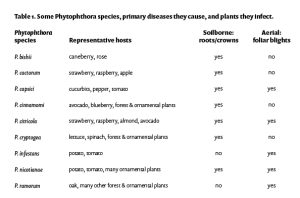
All row crops having root and crown infections can appear delayed in development, stunted and deficient in nutrients due to non-functional roots. With time, these plants wilt, collapse and die. Fruit-bearing row crops can develop a gray to brown rot on fruit if such fruits are in contact with soil or puddled water. Fruit diseases can be seen on cucumber, melon, squash, pepper, tomato and strawberry. Postharvest decay can occur if fruits are infected in the field prior to harvesting.
Foliar blights
Some Phytophthora species can produce airborne or splash-dispersed spores that can infect leaves, stems and fruit that are not touching the ground (Table 1, see page 14). Initial symptoms include small, brown or gray lesions. Such lesions rapidly expand to affect large areas of the foliage, causing it to collapse. Fruits can also be infected by these aerial spores, resulting in fruit rot. Collectively, such diseased foliage and fruit are called blights. As previously mentioned, one of the best known foliar Phytophthora diseases is late blight of potato and tomato caused by P. infestans. Phytophthora capsici causes both root and crown rot diseases as well as foliar blights on cucurbits and other vegetables. While not formally called a “blight,” P. ramorum causes aboveground diseases on foliage, twigs, branches and trunks of many woody trees and shrubs.
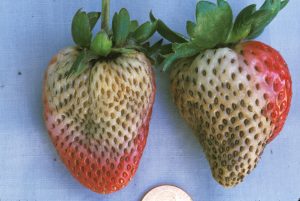
Biology and Disease Development
Phytophthora species are labeled with the common name “water molds.” This is an appropriate name because these organisms are closely connected to water. If sufficient soil moisture is present, Phytophthora will grow mycelium like fungi. If host roots and favorable soil water conditions are present, Phytophthora will produce asexual reproductive structures called sporangia. Sporangia are flask- or oval-shaped structures within which are made zoospores. Zoospores released from these sporangia will swim in the soil water in the direction corresponding to increasing gradients of root exudates, land on roots and initiate infections. Sporangia and zoospores are short-lived structures; if a host root is not found or if soil conditions become too dry, these structures shrivel up and die.
In addition, Phytophthora forms a second type of structure that is spherical, with a thick resilient cell wall, that is called an oospore. Oospores are sexual structures that allow Phytophthora to recombine genetically and form diverse genotypes and strains. With their thick walls, oospores enable the pathogen to survive periods when the soil is dry and host plants are absent. Oospores are the likely means by which these pathogens are spread when contaminated soil is moved from field to field.
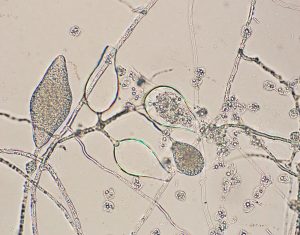
The flask-shaped sporangia of Phytophthora produce zoospores; when sporangia break open, zoospores swim out and infect host roots.
2022-07-14T23:45:47Z
Detection and Diagnostics
Confirmation that Phytophthora is causing a disease requires laboratory testing. Traditional culturing methods, in which pieces of diseased plant tissue are placed into Petri dishes containing selective agar media, are still very useful. More advanced and rapid detection tools include serological methods (such as lateral flow devices or ELISA) in which specifically designed antibodies detect the antigens of Phytophthora and molecular methods (such as qPCR or RPA) in which molecular markers target the Phytophthora DNA. In seeking confirmation of Phytophthora diseases, make sure the diagnostic lab has experience with Phytophthora and uses the appropriate tests.
Diagnostic precision is needed because several soilborne pathogens including Phytophthora cause similar symptoms on row crops. Plant pathogenic species of Pythium and Phytophthora in particular cause very similar root rots, crown infections, foliage yellowing, leaf wilting, poor overall growth and death of the plant (Table 2). Even systemic vascular wilt pathogens such as Fusarium and Verticillium can cause aboveground symptoms that resemble Phytophthora root and crown diseases (Table 2). With so much economic capital committed to the growing of high-value row crops, guessing which pathogen is responsible for losses is too risky. Knowing which pathogen is causing plant loss will help the grower optimize disease management strategies.
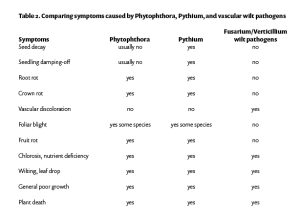
Managing Phytophthora Managing soilborne Phytophthora diseases uses strategies like those deployed against other soilborne pathogens. However, unlike many other soilborne pathogens, post-plant chemical control is a viable option against Phytophthora.
Diagnosis
Have qualified professionals confirm that Phytophthora is the issue; in some cases, it is useful to also know which species of Phytophthora is involved.
Site selection
Choose fields that do not have a history of Phytophthora problems and that have well-draining soils. Soils higher in clay content have been associated with increased risk of Phytophthora.
Crop rotation
If Phytophthora is a concern, avoid back-to-back plantings of the same susceptible crop. Rotate with crops that are not known to be susceptible to the Phytophthora present at that location. Selection of non-susceptible crops will depend on the identification of the Phytophthora species (Table 1).
Irrigation management
Because Phytophthora is dependent on wet soil conditions, carefully schedule irrigations to prevent over watered, saturated soils. Low-flow irrigation systems such as drip irrigation for strawberry and microsprinklers for tree crops, can help discourage Phytophthora outbreaks. When possible, route excess or ponding water away from the production area with the use of ditches, raised beds or slopes.
Sanitation
Sanitation refers to measures used to prevent the introduction or spread of the pathogen in the growing location. Because Phytophthora resides in soil, avoid moving mud-encrusted farm implements from infested areas to clean fields. Avoid using transplants, cuttings and other vegetatively propagated materials that show disease symptoms and are infected with Phytophthora.
Fungicides
For some crops, applying fungicides to the crop may provide some protection. Because Phytophthora is not a true fungus, fungicides with modes of action effective against oomycete diseases are necessary. The repeated use of products having the same mode of action can result in Phytophthora populations that are insensitive (=resistant) to those products; therefore, fungicide applications should include products having different modes of action.
Resistant or tolerant cultivars
There appear to be relatively few row crop cultivars that are genetically resistant to Phytophthora; on the other hand, some cultivars (e.g., the strawberry cultivar Radiance) are known for their increased susceptibility to Phytophthora diseases.
The IPM components for managing soilborne Phytophthora diseases are also relevant for foliar Phytophthora problems and include proper diagnosis, site selection, crop rotation and genetic resistance. For foliar Phytophthora, the mode of irrigation can be extremely critical; the use of overhead sprinkler irrigation can exacerbate Phytophthora blights on cucurbits, tomato, potato and pepper, for example. Sanitation is a key factor for the prevention of epidemics of late blight since P. infestans can over-season on infected plant material. For example, diseased potato tubers, left in old fields or lying in cull piles near production areas, are a source of airborne spores that can infect new plantings. Managing foliar Phytophthora diseases relies more heavily on protectant fungicide sprays than control programs targeting soilborne Phytophthoras. For this reason, careful field scouting plays a critical role for early detection of symptoms and deployment of fungicide tools.


















